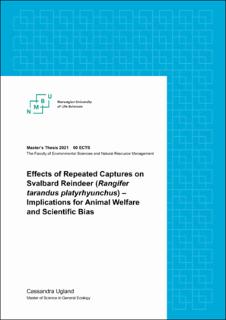| dc.description.abstract | Capturing and marking animals is an essential component of wildlife research. However, data gathered using invasive methods may lead to scientific bias and compromise animal welfare. It is therefore important to evaluate the effects that handling may have on the physiology, behavior, and fitness of captured individuals. Studies with access to both long-term behavioral and physiological data are rare, and so provide an important insight into the full scope of effects handling may have on wildlife. Importantly, multiple metrics should be evaluated because previous studies have found a disconnect between behavioral and physiological responses to capture and handling, where individuals can habituate to one metric, but sensitize to another. A previous study established that there were no fitness effects associated with a single capture event per year for Svalbard reindeer (Rangifer tarandus platyrhynchus). This study therefore examines the effects of repeated captures on individuals’ ability to return to baseline (RTB) values of behavior (activity) and physiology (heart rate), and subsequent fitness of 36 adult, known-aged female Svalbard reindeer. Individuals were captured by use of snowmobiles in March 2018. At the first capture, individuals were sedated and fitted with GPS-collars containing activity sensors and subcutaneous heart rate loggers. As part of a winter energetics study, individuals were recaptured up to 3 times over the next 5 weeks and restrained for blood sampling without sedation. In August of the same year calf-at-heel status was recorded. Generalized linear models and linear mixed-effects models were used to analyze the data with the aim of quantifying how long time the animals used to return to their pre-capture baselines. Capture was found to perturb the return time of both activity and heart rate, but the effect of repeated captures differed between the two metrics. For each subsequent capture, activity took less time to return to baseline, indicating individuals became more tolerant to capture. Heart rate on the other hand took longer to return to baseline with each successive capture, indicating individuals became less tolerant to capture. Individuals captured repeatedly did not significantly differ in body-condition nor reproductive success compared to individuals captured only once, although there was a biologically important effect on daily mass loss of repeated captures. These findings suggest that Svalbard reindeer are physiologically sensitive to repeated captures, despite appearing undisturbed when using behavior in isolation. Repeated capture and handling therefore arguably negatively impacts the welfare of Svalbard reindeer by causing individuals to remain stressed for up to a full day following release. This study highlights the importance of physiological data when examining researcher effects on wildlife and cautions against repeated handling events over short time periods. | en_US |

